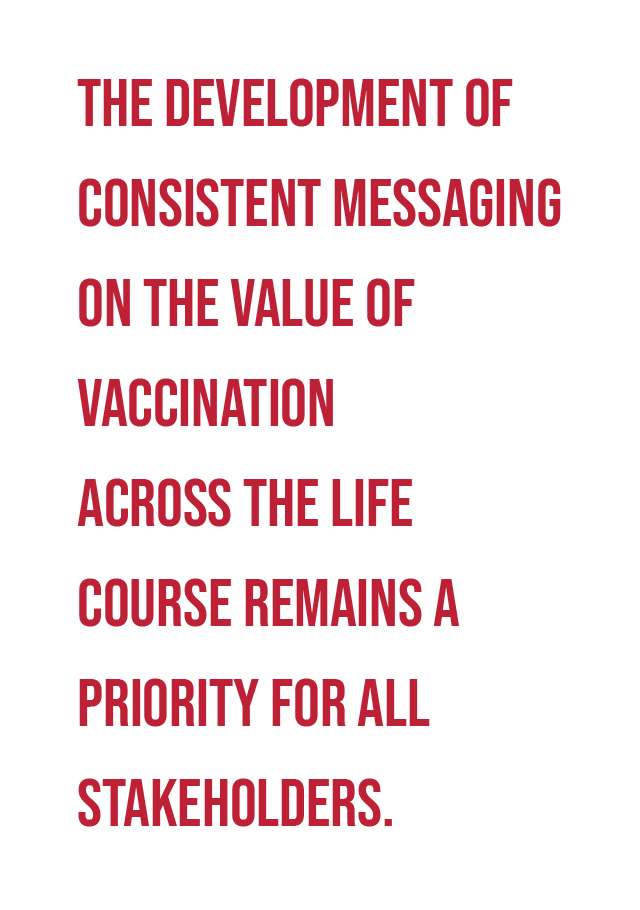Global Health

Nothing in recent years has focused the world’s attention on the development, use, and efficacy of vaccines more than COVID-19. Through efficient public-private partnerships, global R&D platforms generated several highly effective COVID-19 vaccines and governments around the world rallied to approve and administer them within their populations.
But there were bumps in the road. Supply chain problems tied to delivery, trade barriers, and cold chain issues slowed down distribution. Vaccine hesitancy—borne not only from misinformation but also from limited access and understanding of the value of vaccination—put downward pressure on vaccination rates globally. By the end of 2021, nearly a year after multiple vaccines were approved, less than half the world had been vaccinated and significant differences persisted in vaccination rates between countries.
Some governments and companies responded by requiring vaccination and implementing other restrictions designed to encourage vaccine uptake. At the same time, rates for non-COVID child, adolescent, and adult vaccinations fell as the pandemic reduced routine provider visits. Despite these challenges, key developments in vaccine research and commitment to improved healthcare by a range of stakeholders foreshadow continued innovation and public health impact, highlighted by the following.
CONSISTENT MESSAGING WILL DRIVE VACCINATION RATES—AND MORE
Though the situation varies among countries, the development of consistent yet tailored messaging regarding the value of vaccines has become especially important. For routine vaccinations, the focus will remain on developing consistent messaging for both providers and patients, especially around adult immunizations, supported by policymaking aimed at increasing access for all communities. For COVID-19, key steps will remain countering misinformation while developing culturally competent messaging to be used with diverse global populations.
Tailoring these messages to a rapidly changing environment will be especially important as new variants emerge and the science advances. The audience for these messages will go beyond those to whom the vaccine is administered, extending to all stakeholders—including government—focused on immunization financing and policy interventions to support innovation in both vaccine development and delivery.

PUBLIC-PRIVATE PARTNERSHIPS WILL SPEED CHANGE
Developing and fostering partnerships between the public and private sectors, along with collaboration among local and international NGOs and other nongovernmental entities, will be a key driver of both local and global efforts to shape core messaging. Public-private partnerships have had and will continue to have a critical role in pandemic response, not just in communication, but also in building the infrastructure necessary to streamline delivery by identifying and solving challenges related to health system capacity.
A common theme across countries will continue to be increased focus by governments on sustainable immunization infrastructure, particularly financing, through cooperation among government health regulators, trade officials, and customs officials. Now and in the future, the lessons learned and infrastructure developed through the response to COVID-19 can be leveraged for all vaccination programs across the life course.
NEW VACCINES WILL EMERGE—AND NOT JUST FOR COVID-19
What helped drive the rapid development of the COVID-19 vaccines was not just the prior R&D investments in existing vaccine and therapeutic platforms, but also reduced administrative barriers, increased funding, and streamlined regulatory approval processes. Inspired by this, there will be an expansion of the use of innovative vaccine technology platforms for other novel indications, such as HIV and other infectious diseases. This will build on existing innovation in the vaccine pipeline that predates the COVID-19 pandemic.
This spirit of innovation will go beyond the COVID-19 vaccine platform to place much-needed global emphasis on adolescent and adult vaccination, which will be critical as people begin to travel again and are exposed to other infectious, but preventable, diseases. There will also be an emphasis on innovation in the delivery of immunizations, including to address supply chain and distribution challenges, such as cold chain for rural communities, to support broad public health impact.
COVID-19 WILL MOVE FROM PANDEMIC TO ENDEMIC IN FUTURE YEARS
The ultimate goal of the COVID-19 vaccine is to reduce the impact this deadly, highly contagious virus has on the health and well-being of the world by stemming transmission, improving health outcomes following infection, and preventing hospitalization and death. Emerging variants have hindered progress in pandemic response, as have such forces as supply chain issues and vaccine hesitancy.
While many believe that 2022 will see a continuation of COVID-19 as a pandemic, the effects of global progress in the forecasts above is likely to bend the arc of COVID-19 in future years. As COVID-19 transitions to the endemic phase in future years, continued emphasis on sustainable immunization financing, building global health systems capacity, developing consistent messaging on the value of vaccination, and public-private partnership in policymaking will remain critical for responding to public health needs across the immunization life course.